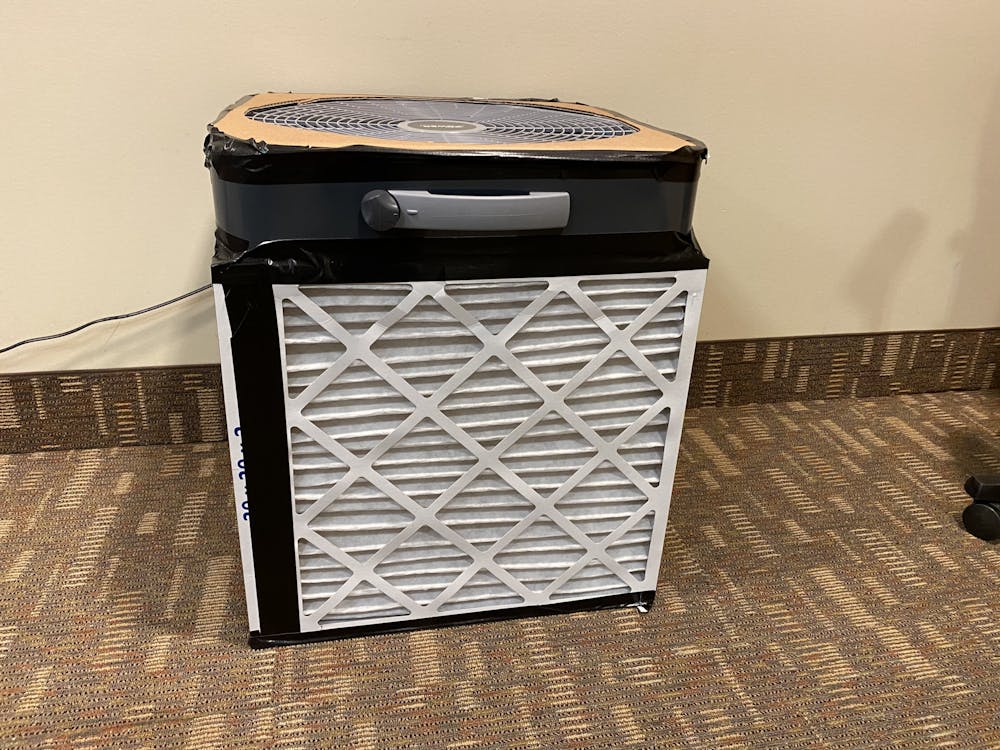The School of Public Health began installing Corsi-Rosenthal Cube air cleaners in SPH classrooms Nov. 1, according to an email sent to the SPH community Oct. 29 by Dean of the School of Public Health Ashish Jha.
The Corsi-Rosenthal box, which was created to combat the spread of COVID-19 by filtering virus particles from the air, consists of a box fan surrounded by air filters on four to five sides. It was developed by Jim Rosenthal, CEO of Air Relief Technologies, and Richard Corsi, dean of engineering at University of California, Davis. The box’s simple design allows people to build it themselves.
University researchers are conducting a study to test the effects of these filters on air quality in the locations where SPH installs them.
Origins of the Cube’s creation
The idea for the box began with a phone call from Wired Magazine in which a reporter asked Rosenthal if he thought that putting one air filter on a box fan would be effective in cleaning the air.
“I went out and tested it, and it worked really well,” Rosenthal said.
Wired published an article with Rosenthal’s initial findings and included suggestions made by Corsi, who suggested using not just one but a box of filters and putting a box fan on top of it.
Deciding to test Corsi’s suggestion, Rosenthal created and tested the device against a $1,000 High Efficiency Particulate Air filter. He found that the box filter was more efficient.
“What makes this box work so well is that the box actually has negative pressure and is sucking things in at a much higher rate than it would (have by) just blowing air through” like the HEPA filter does, Rosenthal said.
The boxes — called Corsi boxes at the time — were used to protect the vice presidential candidates from COVID-19 during the 2020 Vice Presidential Debate, according to The New York Times. Since then, the boxes have exploded in popularity, with people all over the world sharing their own DIY boxes under twitter tags such as #CorsiRosenthal, Rosenthal said.
“We never wanted to patent this. None of this is commercial; it’s all open source,” Rosenthal said. He added that the DIY aspect of the filters is part of what makes the device so appealing to the public.
“It’s gratifying for people to make because it makes you feel that you're not helpless, that you can actually do something… to combat the dangers of COVID,” Rosenthal said.
Testing air quality impact
The placement of the Corsi-Rosenthal Cubes in classrooms at the School of Public Health classrooms will hopefully not only protect students and teachers from COVID-19 but also lead to cleaner air overall, Jha said.
“Indoor air quality has this profound effect on whether you get infectious disease and actually, there's very good evidence that it impacts things like cognition and mood,” Jha said. He added that while the University has upgraded ventilation and filters since the start of the pandemic, the Cubes are a helpful addition because “there's no such thing as air that's too clean.”
To test the effectiveness of the Cubes, a research team led by Associate Professor of Epidemiology Joseph Braun has already started sampling air from SPH classrooms. SPH researchers are collaborating with Professor of Engineering Kurt Panell’s lab and another group at the Silent Spring Institutes to analyze the samples.
The level of air particulates and chemicals in these samples are being measured using samplers and will be compared to future air samples taken after two to four weeks of the addition of the boxes. These samplers collect particulate matter, such as the byproducts of vehicle exhaust that contribute to air pollution, as well as volatile organic compounds and other chemicals.
In addition to measuring air particulate concentrations, the researchers hope to detect chemicals in the air that haven’t been classified yet, Braun said.
“We know there's other chemicals in our environment. We just don't know what they are,” Braun said. “We’re going to use these untargeted methods where we’ll be able to actually detect chemicals … and determine what they might be.” Even if the researchers are unable to determine the exact chemical compounds present, figuring out the type of chemical and where it is likely coming from will still help scientists better understand the indoor environment, according to Braun.
In the future, Braun hopes to expand on this experiment by sampling other University buildings that may be older than the SPH, which was established in 2013. “It would be interesting to go and try this in the dorms, which have old systems and don't have as good of airflow,” he said.
Braun also hopes to bring the Cubes into areas of Providence that are more exposed to air pollution such as in low-income neighborhoods to see if they can help improve air quality.
Next Steps: A community initiative
To give undergraduates the opportunity to get involved in the study, SPH will host an event where undergraduates can make and customize their own Corsi-Rosenthal boxes to place in their dorms or classrooms, Jha said. Although the exact date of the box-building event has not been decided, it is expected to take place in late November.
Jha believes this will be a “great learning opportunity for students to understand how viruses spread and what aerosol transmission is.”
“My hope is that we can make this a super fun exercise. And if it all goes really well, I would also love to do this in partnership with Providence Public Schools and teach students there how to do it,” Jha said.
“I think it’s a really good educational experience,” Jha said. “It lets people understand that they can take control of the quality of air in their own hands.”





